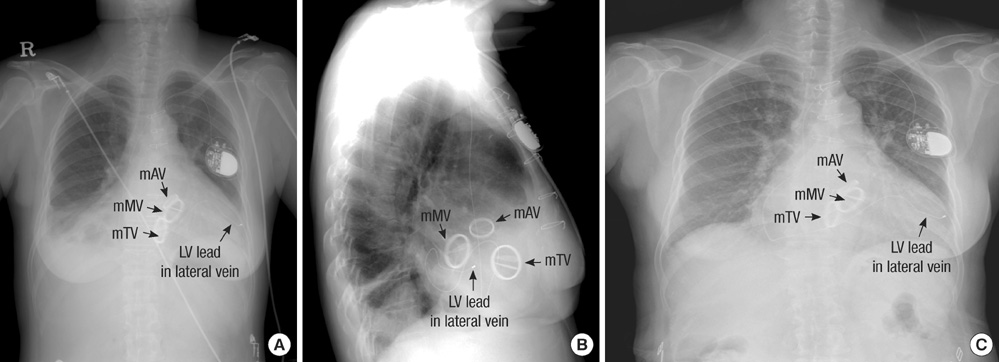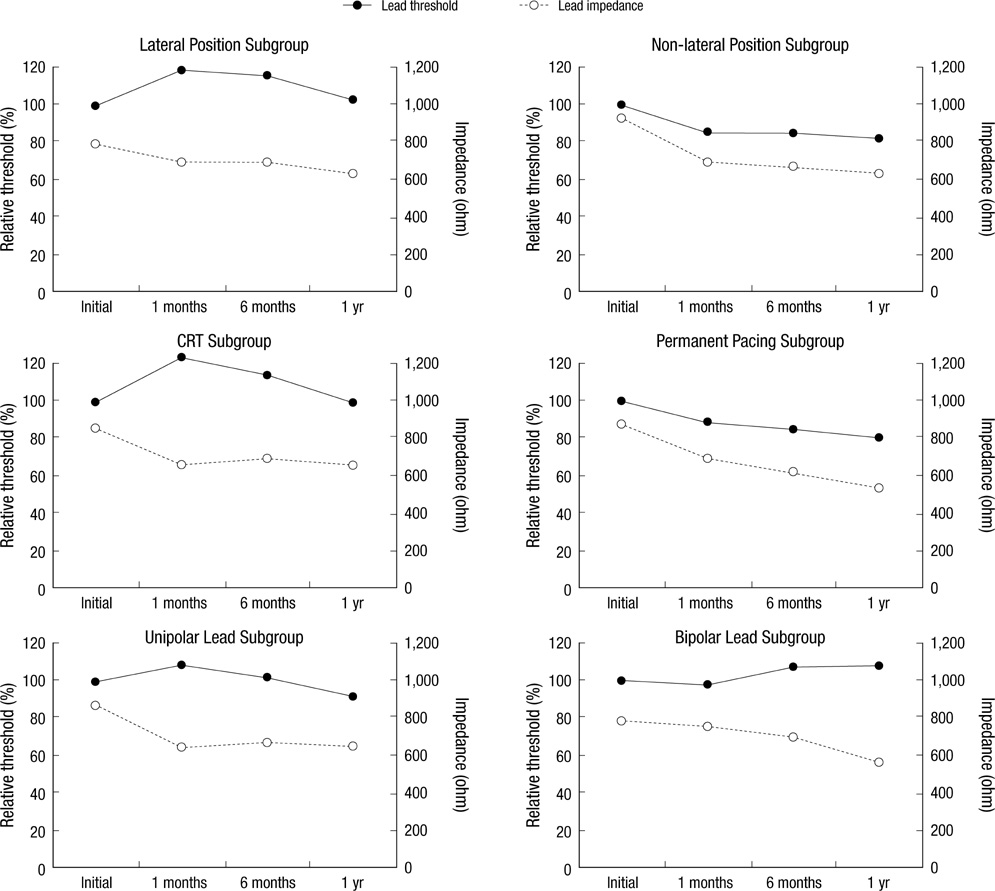J Korean Med Sci.
2010 Oct;25(10):1462-1466. 10.3346/jkms.2010.25.10.1462.
Long-term Prognosis of Left Ventricular Lead
- Affiliations
-
- 1Department of Internal Medicine, Seoul National University College of Medicine, Seoul, Korea. seil@snu.ac.kr
- 2Department of Internal Medicine, Asan Medical Center, University of Ulsan College of Medicine, Seoul, Korea.
- KMID: 2157850
- DOI: http://doi.org/10.3346/jkms.2010.25.10.1462
Abstract
- Transvenous left ventricular (LV) lead implantation is on the increase due to cardiac resynchronization therapy (CRT). However, there has been paucity of data on the prognosis of LV lead. Consecutive 32 patients with LV lead for CRT (n=22) or pacemaker (n=10) were subjected. Serial changes in pacing threshold and impedance along with lead-related complications were evaluated. Over 2 yr follow-up, there was no significant change in relative threshold voltage to the initial value (100%, 110%, 89.6%, and 79.6% at baseline, 1, 6, and 24 months respectively, P=0.62) as well as lead impedance (816+/-272, 650+/-178, 647+/-191, and 590+/-185 ohm at baseline, 1, 6, and 24 months respectively, P=0.80). The threshold change was not affected by lead position, lead polarity, and indication of lead implantation. The cumulative rates of lead revision were 6.3% (n=2) and 9.4% (n=3) in 6 month and 2 yr follow-up, respectively. One case of phrenic nerve capture at left lateral decubitus position was detected 1 month after the implantation. However, there were no serious complications over 2 yr period. In conclusion, transvenous LV lead implantation showed favorable long-term prognosis. Pacing parameters remained stable without significant changes over 2 yr follow-up.
MeSH Terms
Figure
Reference
-
1. Bos HS, Pop GA, Stel EA, van Gelder BM. Dual site coronary sinus pacing in a patient with an artificial tricuspid valve prosthesis. Pacing Clin Electrophysiol. 2004. 27:1451–1452.
Article2. Yoda M, Hansky B, Schulte-Eistrup S, Koerfer R, Minami K. Left ventricular pacing through the anterior interventricular vein in a patient with mechanical tricuspid, aortic and mitral valves. Ann Thorac Surg. 2005. 80:328–330.
Article3. Cleland JG, Daubert JC, Erdmann E, Freemantle N, Gras D, Kappenberger L, Tavazzi L. Cardiac Resynchronization-Heart Failure (CARE-HF) Study Investigators. The effect of cardiac resynchronization on morbidity and mortality in heart failure. N Engl J Med. 2005. 352:1539–1549.
Article4. McAlister FA, Ezekowitz J, Hooton N, Vandermeer B, Spooner C, Dryden DM, Page RL, Hlatky MA, Rowe BH. Cardiac resynchronization therapy for patients with left ventricular systolic dysfunction: a systematic review. JAMA. 2007. 297:2502–2514.5. Ko JS, Jeong MH, Lee MG, Lee SE, Kang WY, Kim SH, Park KH, Sim DS, Yoon NS, Yoon HJ, Hong YJ, Park HW, Kim JH, Ahn Y, Cho JG, Park JC, Kang JC. Left ventricular dyssynchrony after acute myocardial infarction is a powerful indicator of left ventricular remodeling. Korean Circ J. 2009. 39:236–242.
Article6. León AR, Abraham WT, Curtis AB, Daubert JP, Fisher WG, Gurley J, Hayes DL, Lieberman R, Petersen-Stejskal S, Wheelan K. MIRACLE Study Program. Safety of transvenous cardiac resynchronization system implantation in patients with chronic heart failure: combined results of over 2,000 patients from a multicenter study program. J Am Coll Cardiol. 2005. 46:2348–2356.7. Jokinen JJ, Turpeinen AK, Pitkänen O, Hippeläinen MJ, Hartikainen JE. Pacemaker therapy after tricuspid valve operations: implications on mortality, morbidity, and quality of life. Ann Thorac Surg. 2009. 87:1806–1814.
Article8. Koplan BA, Stevenson WG, Epstein LM, Aranki SF, Maisel WH. Development and validation of a simple risk score to predict the need for permanent pacing after cardiac valve surgery. J Am Coll Cardiol. 2003. 41:795–801.
Article9. Jung SH, Lee JW, Je HG, Choo SJ, Chung CH, Song H. Surgical outcomes and post-operative changes in patients with significant aortic stenosis and severe left ventricle dysfunction. J Korean Med Sci. 2009. 24:812–817.
Article10. Shinn SH, Oh SS, Na CY, Lee CH, Lim HG, Kim JH, Yie KS, Baek MJ, Song DS. Short- and long-term results of triple valve surgery: a single center experience. J Korean Med Sci. 2009. 24:818–823.
Article11. Daoud EG, Kalbfleisch SJ, Hummel JD, Weiss R, Augustini RS, Duff SB, Polsinelli G, Castor J, Meta T. Implantation techniques and chronic lead parameters of biventricular pacing dual-chamber defibrillators. J Cardiovasc Electrophysiol. 2002. 13:964–970.
Article12. Nof E, Gurevitz O, Carraso S, Bar-Lev D, Luria D, Bachar S, Eldar M, Glikson M. Comparison of results with different left ventricular pacing leads. Europace. 2008. 10:35–39.
Article13. Bulava A, Lukl J. Single-centre experience with coronary sinus lead stability and long-term pacing parameters. Europace. 2007. 9:523–527.
Article14. Pavia S, Wilkoff B. The management of surgical complications of pacemaker and implantable cardioverter-defibrillators. Curr Opin Cardiol. 2001. 16:66–71.
Article15. Kiviniemi MS, Pirnes MA, Eranen HJ, Kettunen RV, Hartikainen JE. Complications related to permanent pacemaker therapy. Pacing Clin Electrophysiol. 1999. 22:711–720.
Article16. Hill PE. Complications of permanent transvenous cardiac pacing: a 14-year review of all transvenous pacemakers inserted at one community hospital. Pacing Clin Electrophysiol. 1987. 10:564–570.
Article
- Full Text Links
- Actions
-
Cited
- CITED
-
- Close
- Share
- Similar articles
-
- Ventricular dyssynchrony in patients with permanent pacemaker
- Successful Placement of a Left Ventricular Pacing Lead Despite Coronary Sinus Dissection During Cardiac Resynchronization Therapy
- Acute Myocardial Infarction in 14-Year-Old Male of Primary Pulmonary Hypertension with Left Ventricular Hypertrophy : A Case Report
- Left ventricular function after mitral valve operation in congenital mitral regurgitation
- Echocardiographic Evaluation of Left Ventricle before and after Maximum Exercise in Track Athletes




